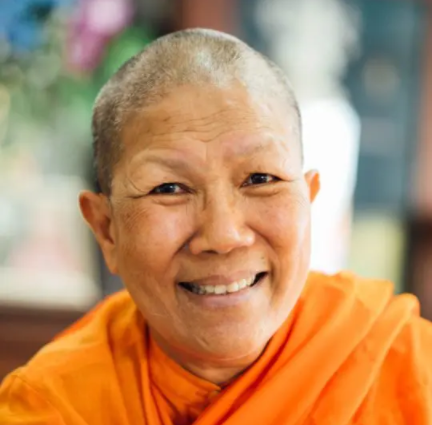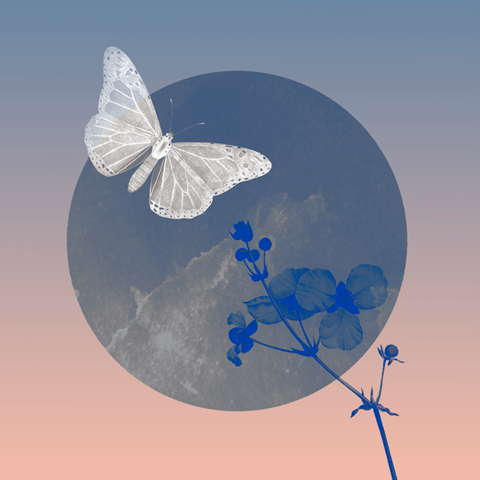It's not easy thinking about the smallest things in nature.
We can think, There's a pebble.
There's a grain of sand.
There's a speck.
But when we get below speck-level, to cells and molecules and atoms which can't be seen, thinking about the smallest scales is a deeply intellectual exercise.
And one of the great champions of nano-scale thinking turns out to be, of all people, the Buddha!
 |
| That’s him, in the center, sitting cross-legged and wearing a princely hat. He astounds the gathered crowd with his knowledge of math and numbers, his fingers poised as he counts units of the infinitely large and small (Bhante Anandajoti). |
.
My friend Ezra Block read about the Buddha's special abilities in a book called The Universal History of Numbers by Georges Ifrah. And we've been exchanging notes:
Robert Krulwich: So tell me the story.
Ezra Block: Georges Ifrah tells a tale about the Buddha [the Scythian Prince Siddhartha Gautama who renounced the world to gain enlightenment] that comes from an ancient text known as the "Lalitavistara Sutra" (basically a collection of "did you hear about the time he...?" stories), which recounts how the Buddha [prior to enlightenment while still a prince] had to compete with other suitors for the hand of Gopa.
Krulwich: Gopa is a lady he likes?
Block: Gopa is lady he likes a lot. But Gopa's dad didn't want his daughter to marry just anyone, so he set up a competition. Those wishing to wed Gopa were required to perform all sorts of artistic, athletic, and mental feats in order to prove their worthiness.
Krulwich: Like...?
Block: Like archery contests, physical competition, and yes, mathematics.
Krulwich: Wasn't he some kind of prince?
Block: Oh yes. He was called Prince Siddhartha. And even as princes go, he was in a special class. Buddhist stories pump him to be superhuman -- from conception and birth and throughout his entire life.
Krulwich: So tell me about the math competition...
Block: Well there's this episode about a counting contest between [Prince Siddhartha before he was] the Buddha and a mathematician named Arjuna, where the prince is asked to calculate both a very big number and, yes, a very, very small number.
Krulwich: Is that hard?
Block: Well, the small problem was to count the number of -- I guess you could call them --
atoms [called
kalapas in Buddhist physics], the smallest possible unit, in a
yojana [a measure of distance usually considered about seven miles].
Krulwich: What's a yojana?
Block: According to Alex Bellos, a journalist who included this tale in his new book Here's Looking at Euclid, a yojana is an ancient unit of length equivalent to around 10 kilometers.
Krulwich: So the question is, roughly, How many atoms are there in a line 10 kilometers long?
Block: Kind of. And here, courtesy of the ancient texts, is his solution:
- A yojana, the Buddha said, is equivalent to 4 krosha,
- each of which was the length of 1,000 arcs,
- each of which was the length of 4 cubits,
- each of which was the length of
2 spans,
- each of which was the length of
12 phalanges of [the] fingers,
- each of which was the length of
7 grains of barley,
- each of which was the length of
7 mustard seeds,
- each of which was the length of
7 particles of dust stirred up by a cow,
- each of which was the length of
7 specks of dust disturbed by a ram,
- each of which was the length of 7 specks of dust stirred up by a hare,
- each of which was the length of
7 specks of dust carried away by the wind,
- each of which was the length of
7 tiny specks of dust,
- each of which was the length of
7 minute specks of dust,
- each of which was the length of
7 particles of the first atoms.
So here's the neat part. According to Alex Bellos, it turns out the [future] Buddha's calculation got the size of an atom very close to right!
This was, in fact, a pretty good estimate. Just say that a finger is 4 centimeters long. The Buddha's "first atoms" are, therefore, 4 centimeters divided by 7 ten times, which is 0.04 meter times 7 to the minus 10 or 0.00000000001416 meter, which is more or less the size of a carbon atom.
Krulwich: Wow!
Block: Well, remember, this is a legend, so I wouldn't like fall on my knees or anything...
Krulwich: But still...
Block: Maybe the neat thing here lies in the notion that the civilization that gave rise to Buddhism [Scythia and proto-India in the country of Magadha] was also the same civilization and [Indus Valley Civilization] culture that had a thing for and a means to express -- usefulness aside -- infinitely large and small numbers.
A number describing the size of a carbon atom would be meaningless in a society that had no notion of atoms or building blocks of that scale.
Here's a group of ancient people (ancient Indians) trying not only to comprehend the infinite but somehow thought it important to name so many divisions of infinitely large and small.
- [NOTE: The Vedas or ancient sacred texts of the Indus Valley Civilization held sacred in modern India did have a concept of the atom, the smallest indivisible unit, which they later taught the ancient Greeks in Bactria, Sogdiana, and Scythia. A kalapa or Buddhist "particle," however, is not quite as we imagine, just as the atom is not. It is materiality expressed by the Four Elements (maha dhatu) referred to as ancient categories of earth, fire, water, and air -- which are, in fact, the qualities or characteristics of solidity, temperature, cohesion, movement, and so on. See Four Elements Meditation by the enlightened living Buddhist teacher Ven. Pa-Auk Sayadaw for direct comprehension of these personally verifiable facts; it is not mere theory.]
Krulwich: So why did they do it?
Block: I don't know. Maybe this is where poetry meets mathematics? The act of dividing has a kind of mystery. And beauty.
Krulwich: Maybe. When you go below atomic size and get down to quarks, you drop off the periodic table and start playing with James Joyce who coined the word "quark." I think we should stop here.
Ezra: The Buddha [when he was still but a very bright Scythian prince in Shakya Land] did.
More 























